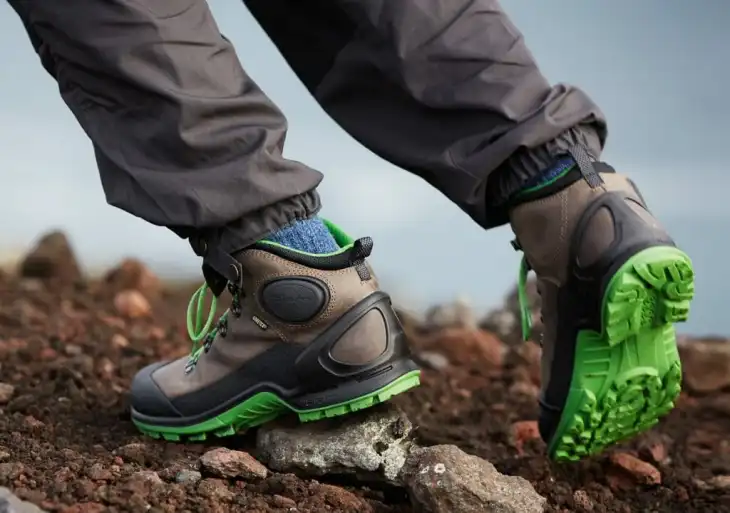Footwear manufacturers bounce the terms waterproof and water-resistant around a lot. However, understanding these technologies’ differences is essential for selecting the best footwear for hiking in wet environments.
Boots or shoes labeled as waterproof have a breathable membrane. These membranes seal the seams of boots and provide a protective barrier against rain.
Waterproofness
When you’re planning for a hike in wet weather conditions, you want to ensure your feet will be protected. Waterproof hiking shoes feature a waterproof membrane that is layered into the leather and synthetic materials of the shoe to keep water out. The membrane also escapes moisture, so your feet don’t get too sweaty while hiking. Notably, brands like Hoka One One incorporate advanced waterproofing technologies into their hiking shoe designs, offering reliable protection and comfort for outdoor enthusiasts exploring various terrains and weather conditions.
To be labeled waterproof, boots and shoes must pass the hydrostatic head test, where water is forced against the fabric to see how much it can hold before leaking. A good rule of thumb is that waterproof hiking shoes can withstand 200 mm of liquid pressure before they leak. This is enough for most hiking adventures, but be careful not to avoid submerging your boots in standing water or creek crossings.
Non-waterproof hiking shoes don’t have a protective membrane, but they can still repel moisture and allow air to escape through the mesh and leather uppers. This breathability is crucial in hot and humid weather, especially on multi-day hikes when you’ll be constantly sweating. As sweat and moisture evaporate, your feet cool down through the evaporative cooling process. Non-waterproof hiking shoes dry faster than waterproof models if soaked in a rainstorm or creek crossing.
Breathability
The breathable fabric and ventilation found in non-waterproof hiking shoes are excellent for transferring sweat away from feet, keeping them more relaxed and allowing them to dry more quickly. Depending on the climate and terrain you hike, this can be critical to your comfort.
Most breathable hiking shoes are constructed of tightly woven synthetics (like polyester or nylon) and open-mesh materials. These fabrics are lighter than leather, break in faster, and cost less. They can also be treated with a durable water-repellent coating such as DWR, which will repel light moisture upon contact but may wear off over time.
Waterproof hiking shoes have uppers built with waterproof/breathable membranes. These fabrics have tiny pores that block water molecules but allow air to flow freely. They’re great for creek crossings, surprise rainfall, or hiking in snow. However, the extra layer adds weight and impacts breathability significantly, so be careful when going this route.
Some brands make waterproof footwear with an outer layer of PU, which can withstand moderate rain showers but is less breathable than other hiking shoe technology. If you’re looking for lightweight hiking shoes that protect you from the elements, look for a high-end product.
Insulation
Waterproof hiking shoes and boots feature a lining or membrane inside the shoe that’s bonded to the outer shell of the footwear. The Gore-Tex membrane is made of expanded polytetrafluoroethylene (commonly shortened to ePTFE) sandwiched between a lining and a stabilizing knit backer before being sewn into the footwear.
Hiking footwear billed as waterproof usually has to pass a hydrostatic head test that requires the footwear to be submerged in water at a pressure equal to or greater than its weight. Depending on the brand, some waterproof footwear also includes additional features that make it better for hiking in snow and mud.
While most waterproof hiking shoes and boots offer good breathability, they can still become hot and sweaty when the footwear gets wet or if you wear thick socks for extended periods. Waterproof footwear costs more and weighs more than non-waterproof hiking shoes or boots.
For hikers who plan on hiking in a dry climate, especially hot and dry, like the desert canyons of Southern Utah or the mountains of California and Arizona, a lightweight, non-waterproof boot might be a better option as it will save money and reduce shoe weight. Those extra ounces can add up over many miles and days on the trail for ultralight backpackers and thru-hikers.
Weight
While waterproof shoes may keep moisture out, they also seal sweat in. Over time, this can lead to foot discomfort and clamminess. In contrast, non-waterproof boots are designed with ventilated uppers and breathable mesh liners, allowing sweat to escape more easily.
Choosing the correct type of hiking shoes depends on terrain and climate. For example, hikers in snow-covered environments might need heavier, more insulated shoes to keep their feet warm and dry.
Traditional waterproof shoe materials include rubber, polyvinyl chloride (PVC), and leather. These are often stiff and rigid on the foot, making them less comfortable than flexible options like nylon and synthetic fabrics. Nowadays, manufacturers are exploring innovative ways to make shoes and boots more breathable without sacrificing waterproof protection.
One new technology involves coating the inside of shoes with an intelligent nanoparticle layer that keeps water away from the inner fabric and allows air to circulate freely. This innovation can help minimize the buildup of sweat and prevent odors, which can occur when shoes are saturated with moisture.
The bottom line is that waterproof hiking shoes can be just as breathable and comfortable as non-waterproof footwear, but they usually cost more and weigh more. They also require additional care and maintenance. For instance, waterproof shoes treated with waterproofing membrane must be retreated periodically using a spray-on or wash-in revival product.
